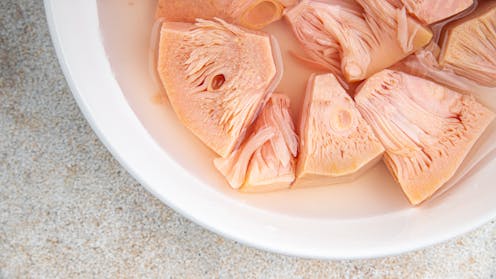Māori bread and jackfruit join other new foods in the country’s nutritional database
- Written by Nick William Smith, Associate Investigator in Nutritional Science, Te Kunenga ki Pūrehuroa – Massey University

The latest update to the New Zealand food composition database, a comprehensive collection of nutrient data collated jointly by Plant & Food Research and the Ministry of Health, brings more than just numbers: it adds insights into culturally important foods and their role in diets.
For the first time, certain traditional foods such as rēwena (Māori bread) and ingredients such as natto, paneer, jackfruit and lentils are included. Alongside these are modern supermarket staples, including lactose-free yoghurts and dairy-free cheeses.
As New Zealand’s population continues to diversify and people’s food choices evolve, the database is keeping pace, ensuring everyone’s plate is represented. The latest update introduces 191 new or updated food records, each with a detailed list of all nutrients, from a wide range of culturally relevant, plant-based and speciality diet foods. These include:
traditional Māori foods such as rēwena
ethnic staples, including natto, paneer, black beans
-
high-protein yoghurts, dairy-free cheeses and lactose-free options, reflecting market trends.
New Zealanders’ changing food habits
New Zealand’s population is becoming more ethnically diverse. The 2023 census shows nearly a third of New Zealand residents were born overseas and the population of people with Asian ethnicity is the fastest growing in the country. Our supermarkets and food services reflect these changes in their offering.
At the same time, demand is growing for plant-based options, allergen-friendly foods and products tailored to different dietary needs. The database update captures these shifts, offering data on foods that might previously have been overlooked or underestimated.
For example, including rēwena means nutrition professionals working with Māori communities or individuals can offer tailored advice using culturally relevant foods. Including natto or paneer gives dietitians more information to support New Zealanders of Asian or Indian heritage.
The newly added foods weren’t chosen at random. They reflect real changes in the way New Zealanders eat, informed by surveys that reflect the quantities of foods consumed and also how important they are for delivering essential nutrients. The additions also capture new products available in supermarkets or significant changes in recipes.
Foods are collected from around the country to represent our geographically spread population. They are then sent for independent lab analysis to quantify their content of macro (proteins, carbohydrates, fats) and micronutrients (minerals and vitamins).
Including new foods ensures the database stays relevant for a modern, multicultural population and provides accurate nutrition information for consumers, healthcare providers, food businesses and researchers. This facilitates future national surveys to more accurately capture the diversity of New Zealand diets and their implications for population nutrition.
Where these new foods sit in a healthy diet
With the addition of 74 new food components, including detailed profiles of fatty acids and a new method for measuring dietary fibre, the database doesn’t just tell us what is in our food, but also how these foods contribute to nutrition.
Many of the newly included foods are rich in protein, dietary fibre or plant-based nutrients. This is true for rēwena, which includes potato and is higher in protein and dietary fibre than most white breads. Black beans and lentils are affordable sources of protein and iron, while jackfruit offers a low-fat, meat-like texture for vegetarian meals.
The database is reviewed and updated every two years to reflect what people are actually eating. With 2,857 foods and 434 nutrient components now in the system, it offers an unparalleled window into New Zealand’s food supply and provides information to support national nutrition surveys and dietary intake studies.
The data also supports educational resources, such as those produced by organisations that encourage New Zealanders to eat fruits and vegetables.
The food composition database is New Zealand’s most comprehensive source of high-quality nutrient data. It is used by researchers, the food industry, public health agencies and regulators to develop and reformulate products, create accurate nutrition labels, model dietary trends and monitor how changing food habits affect nutrition.
Authors: Nick William Smith, Associate Investigator in Nutritional Science, Te Kunenga ki Pūrehuroa – Massey University





